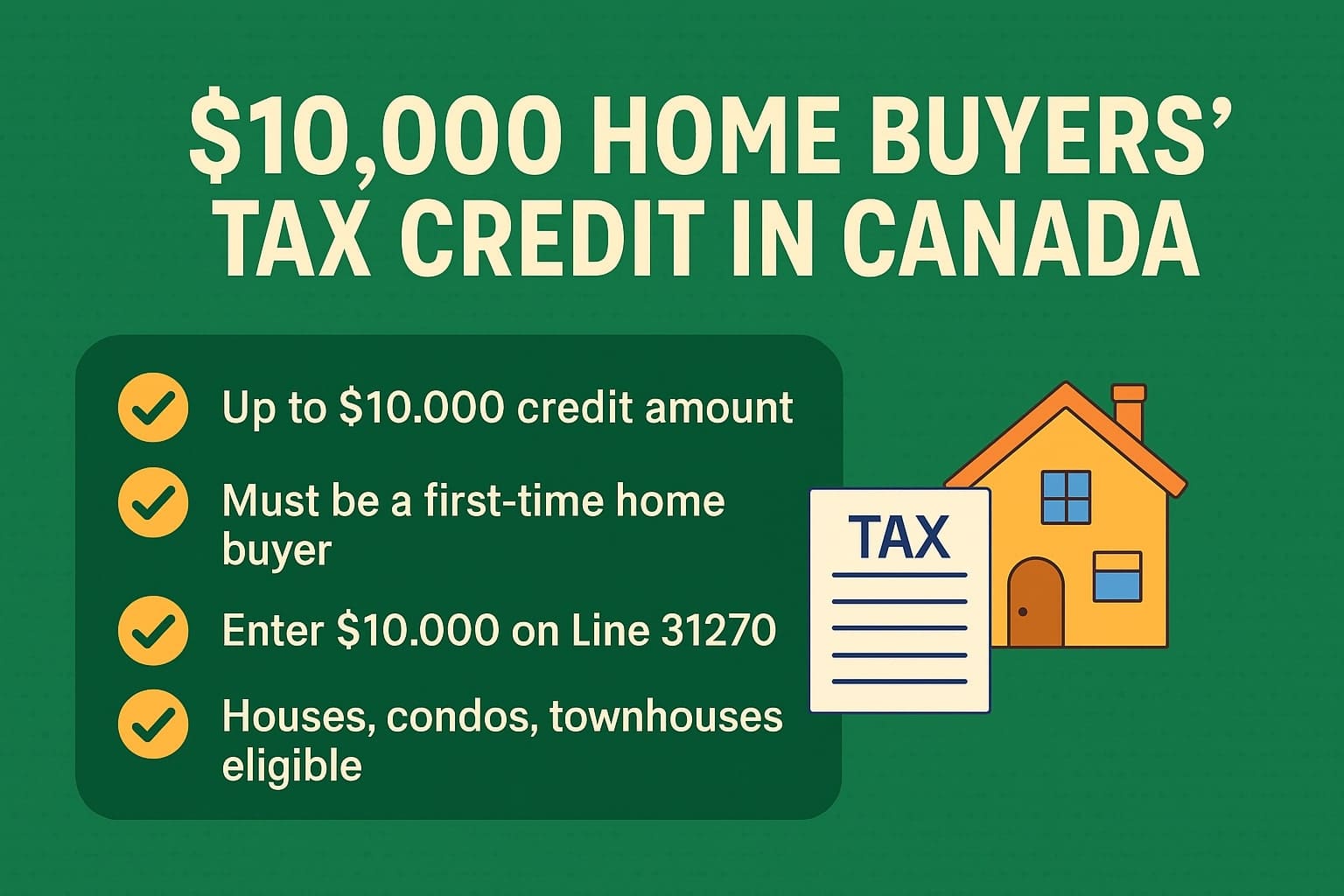Buying a home in Canada is a major milestone, but it also comes with financial challenges. To ease this burden, the Canadian government offers the First-Time Home Buyers’ Tax Credit (HBTC). As of 2022, this credit was doubled to $10,000, providing up to $1,500 in tax relief. In this guide, we explain how the HBTC works, who qualifies, how to claim it, and other related home-buying incentives that can help you save more.
What is the $10,000 Home Buyers’ Tax Credit (HBTC)?
The HBTC is a non-refundable tax credit offered by the Government of Canada to support first-time homebuyers. When you claim the $10,000 credit, you can reduce your tax liability by up to $1,500 (15% of $10,000). While it doesn’t give you a refund if your taxes are already zero, it can lower what you owe.
Key Features of the HBTC
| Credit Amount | Up to $10,000 |
| Tax Savings | Reduces federal income tax by up to $1,500 |
| Eligibility | Must be a first-time homebuyer |
| How to Claim | Enter $10,000 on Line 31270 of your tax return |
| Qualifying Homes | Houses, condos, townhouses, mobile homes, etc. |
| Special Provision | Available to individuals with disabilities, even if not first-time buyers |
Eligibility Criteria for the HBTC
To qualify, you must meet all of the following conditions:
✅ 1. First-Time Home Buyer
You or your spouse/common-law partner must not have owned and lived in a home in the last four years.
✅ 2. Purchase of a Qualifying Home
• Must be located in Canada
• Types: detached homes, semi-detached, townhouses, condos, mobile homes
• Registered in your or your partner’s name
✅ 3. Intention to Occupy
You must plan to live in the home within one year of the purchase.
✅ 4. Disability Exception
If you qualify for the Disability Tax Credit (DTC), you can still claim the HBTC even if you’re not a first-time buyer—provided the home improves accessibility.
How to Claim the HBTC
Claiming your $10,000 tax credit is easy;
-
Confirm Eligibility
Make sure you meet all requirements. -
Complete Tax Return
On your T1 General Return, enter $10,000 on Line 31270. -
Split the Credit (if applicable)
Buying with a spouse or partner? You can share the credit, but the combined total cannot exceed $10,000.
Example of HBTC in Action
Let’s say you owe $2,000 in taxes. Claiming the HBTC reduces your tax by $1,500, meaning you’ll only pay $500.
If you owe only $1,000, the HBTC reduces it to zero, but you won’t get a $500 refund, since it’s non-refundable.
What Types of Homes Qualify?
You can claim the HBTC if your new home is;
- A detached or semi-detached house
- A townhouse or rowhouse
- A condominium unit
- A mobile home or modular home
- An apartment in a duplex, triplex, or fourplex
The property must be in Canada and intended to be your primary residence.
Other Programs for First-Time Home Buyers
1. Home Buyers’ Plan (HBP)
• Withdraw up to $35,000 from your RRSP tax-free
• Must repay within 15 years
2. First Home Savings Account (FHSA)
• Contribute up to $8,000 per year, up to $40,000 total
• Withdrawals are completely tax-free for home purchases
3. GST/HST New Housing Rebate
• Reclaim part of the GST/HST paid on new or renovated homes
• Available to qualifying first-time buyers
Frequently Asked Questions (FAQs)
Q: Can I share the tax credit with my partner?
Yes. If you’re co-buyers, you can split the $10,000 credit—but the total claimed must not exceed $10,000.
Q: Will I get a refund if my tax is already low?
No. The HBTC is non-refundable. It only reduces taxes owed, not beyond zero.
Q: Can I use this credit for a rental property?
No. The home must be your principal residence within one year of purchase.
Q: Can I claim the HBTC more than once?
Only if you become eligible again—i.e., you haven’t owned a home for at least four years.
Final Thoughts
The $10,000 First-Time Home Buyers’ Tax Credit is a powerful tool to lower your tax burden when stepping into homeownership. Pair it with other benefits like the HBP and FHSA for maximum savings. Whether you’re buying a condo, townhouse, or your first detached home, understanding and claiming these credits can save you thousands.


